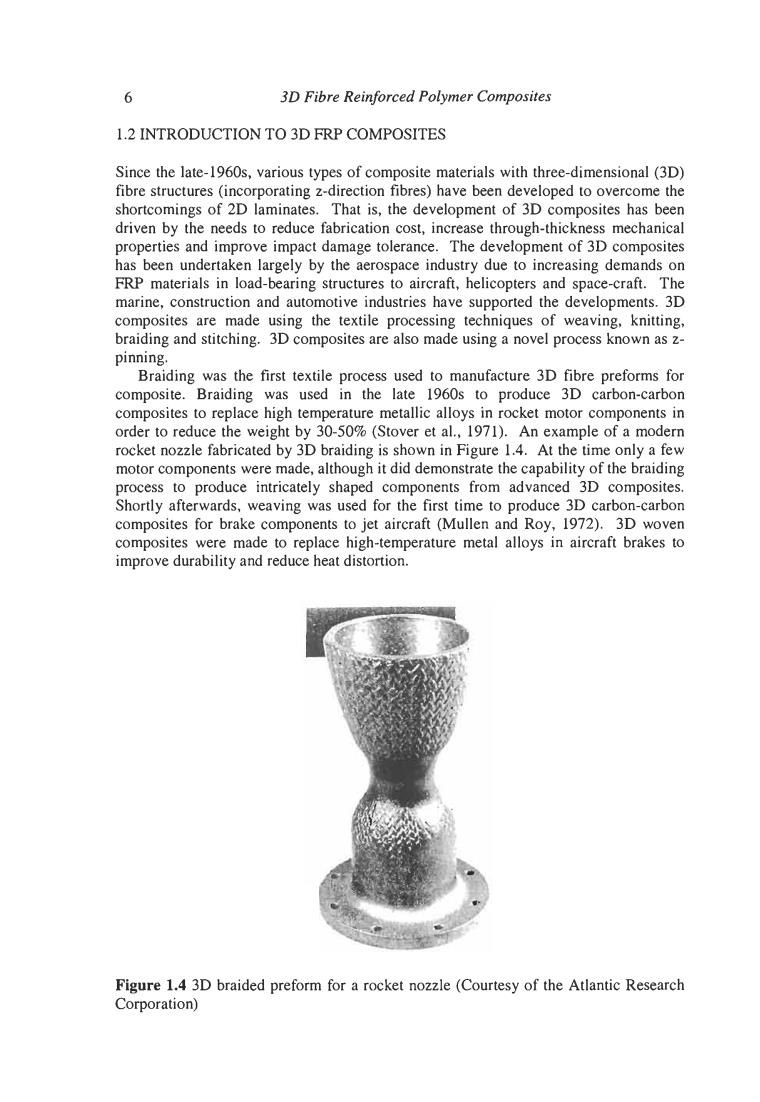正在加载图片...

6 3D Fibre Reinforced Polymer Composites 1.2 INTRODUCTION TO 3D FRP COMPOSITES Since the late-1960s,various types of composite materials with three-dimensional(3D) fibre structures (incorporating z-direction fibres)have been developed to overcome the shortcomings of 2D laminates.That is,the development of 3D composites has been driven by the needs to reduce fabrication cost,increase through-thickness mechanical properties and improve impact damage tolerance.The development of 3D composites has been undertaken largely by the aerospace industry due to increasing demands on FRP materials in load-bearing structures to aircraft,helicopters and space-craft.The marine,construction and automotive industries have supported the developments.3D composites are made using the textile processing techniques of weaving,knitting, braiding and stitching.3D composites are also made using a novel process known as z- pinning. Braiding was the first textile process used to manufacture 3D fibre preforms for composite.Braiding was used in the late 1960s to produce 3D carbon-carbon composites to replace high temperature metallic alloys in rocket motor components in order to reduce the weight by 30-50%(Stover et al.,1971).An example of a modern rocket nozzle fabricated by 3D braiding is shown in Figure 1.4.At the time only a few motor components were made,although it did demonstrate the capability of the braiding process to produce intricately shaped components from advanced 3D composites. Shortly afterwards,weaving was used for the first time to produce 3D carbon-carbon composites for brake components to jet aircraft (Mullen and Roy,1972).3D woven composites were made to replace high-temperature metal alloys in aircraft brakes to improve durability and reduce heat distortion. Figure 1.4 3D braided preform for a rocket nozzle(Courtesy of the Atlantic Research Corporation)6 30 Fibre Reinforced Polymer Composites 1.2 INTRODUCTION TO 3D FRF' COMPOSITES Since the late-l960s, various types of composite materials with three-dimensional (3D) fibre structures (incorporating z-direction fibres) have been developed to overcome the shortcomings of 2D laminates. That is, the development of 3D composites has been driven by the needs to reduce fabrication cost, increase through-thickness mechanical properties and improve impact damage tolerance. The development of 3D composites has been undertaken largely by the aerospace industry due to increasing demands on FRP materials in load-bearing structures to aircraft, helicopters and space-craft. The marine, construction and automotive industries have supported the developments. 3D composites are made using the textile processing techniques of weaving, knitting, braiding and stitching. 3D composites are also made using a novel process known as zpinning. Braiding was the first textile process used to manufacture 3D fibre preforms for composite. Braiding was used in the late 1960s to produce 3D carbon-carbon composites to replace high temperature metallic alloys in rocket motor components in order to reduce the weight by 30-5096 (Stover et al., 1971). An example of a modern rocket nozzle fabricated by 3D braiding is shown in Figure 1.4. At the time only a few motor components were made, although it did demonstrate the capability of the braiding process to produce intricately shaped components from advanced 3D composites. Shortly afterwards, weaving was used for the first time to produce 3D carbon-carbon composites for brake components to jet aircraft (Mullen and Roy, 1972). 3D woven composites were made to replace high-temperature metal alloys in aircraft brakes to improve durability and reduce heat distortion. Figure 1.4 3D braided preform for a rocket nozzle (Courtesy of the Atlantic Research Corporation)